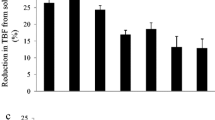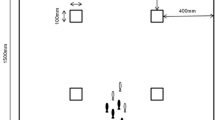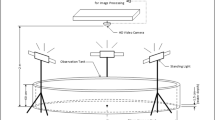Abstract
Group living among fishes has notable biological significance for individual well being and survival. However, group swimming dynamics have been historically difficult to quantify due to the complexity of the different movement patterns. This study describes and evaluates software developed for the analysis of schooling, shoaling, and solitary behaviors in the mummichog, Fundulus heteroclitus. Analysis of simulated data sets indicated accuracy of the software to within 0.06% of known values (i.e., no functional difference in observed versus expected; P = 0.58–0.93 for all parameters tested). Results from an acclimation experiment with groups of mummichog included decreased schooling, shoaling, individual velocity, and number of interactions after 24 h (P ≤ 0.05). In addition, there was an increase in shoaling nearest-neighbor angle (NNA) and distance (NND) over time (P ≤ 0.05). No changes in group behaviors were observed during different periods within 1 day (09:00, 12:00, 15:00, and 18:00 h) after 72 h in the arenas (P > 0.05). These results describe decreased social interactions and polarization (degree of unity in movement) over time. This software is applicable to the study of behavioral ecology of fish to discern changes in group dynamic behaviors.


Similar content being viewed by others
References
Alexander RD (1974) The evolution of social behavior. Annu Rev Ecol Syst 5:325–383
Aoki I (1980) An analysis of the schooling behavior of fish: internal organization and communication process. Bulletin of the Ocean Research Institute. University of Tokyo, Tokyo
Breder CM (1954) Equations descriptive of fish schools and other animal aggregations. Ecology 35:361–370
Bumann D, Krause J (1993) Front individuals lead in shoals of 3-spined sticklebacks (Gasterosteus aculeatus) and juvenile roach (Rutilus rutilus). Behaviour 125:189–198
Connell SD, Gillanders BM (1997) Proceedings of the 8th International Coral Reef Symposium, Panama City
Couzin ID, Krause J, James R, Ruxton GD, Franks NR (2002) Collective memory and spatial sorting in animal groups. J Theor Biol 218:1–11
Fritz ES, Meredith WH, Lotrich VA (1975) Fall and winter movements and activity level of the mummichog, Fundulus heteroclitus, in a tidal creek. Chesapeake Sci 16:250–261
Fuiman LA, Webb PW (1988) Ontogeny of routine swimming activity and performance in zebra danios (Teleostei, Cyprinidae). Anim Behav 36:250–261
Gallego A, Heath MR (1994) The development of schooling behavior in Atlantic herring Clupea harengus. J Fish Biol 45:569–588
Grand TC, Dill LM (1999) The effect of group size on the foraging behaviour of juvenile coho salmon: reduction of predation risk or increased competition? Anim Behav 58:443–451
Grunbaum D (1998) Schooling as a strategy for taxis in a noisy environment. Evol Ecol 12:503–522
Hamilton WD (1971) Geometry for the selfish herd. J Theor Biol 31:295–311
Hartwell SI, Hocutt CH, Vanheukelem WF (1991) Swimming response of menhaden (Brevoortia tyrannus) to electromagnetic pulses. Z Angew Ichthyol 7:90–94
Hassan ES, Abdellatif H, Biebricher R (1992) Studies on the effects of Ca2+ and Co2+ on the swimming behavior of the blind Mexican cavefish. J Comp Physiol A: Sensory Neural Behav Physiol 171:413–419
Higgs DM, Fuiman LA (1996) Light intensity and schooling behaviour in larval gulf menhaden. J Fish Biol 48:979–991
Hoare DJ, Ruxton GD, Godin JGJ, Krause J (2000) The social organization of free-ranging fish shoals. Oikos 89:546–554
Hunter JR (1966) Procedure for analysis of schooling behavior. J Fish Res Board Can 23:547–562
Inada Y, Kawachi K (2002) Order and flexibility in the motion of fish schools. J Theor Biol 214:371–387
Johnsson JI (2003) Group size influences foraging effort independent of predation risk: an experimental study on rainbow trout. J Fish Biol 63:863–870
Kane AS, Salierno JD, Gipson GT, Molteno TCA, Hunter C (2004) A video-based movement analysis system to quantify behavioral stress responses of fish. Water Res 38:3993–4001
Kanehiro H, Suzuki M, Matuda K (1985) Characteristics of schooling behavior by the group size of rose bitterling in the experimental water tank. Bull Jpn Soc Sci Fish 51:1977–1982
Koltes KH (1985) Effects of sublethal copper concentrations on the structure and activity of Atlantic silverside schools. Trans Am Fish Soc 114:413–422
Koltrschal K, Essler H (1995) Goals and approaches in the analysis of locomotion in fish, with a focus on laboratory studies. Rev Fish Sci 3:171–200
Masuda R, Tsukamoto K (1998) The ontogeny of schooling behaviour in the striped jack. J Fish Biol 52:483–493
Nichols J, Breder CMJ (1927) The marine fishes of New York and southern New England. Zoologica IX:1–192
Niwa HS (1994) Self-organizing dynamic model of fish schooling. J Theor Biol 171:123–136
Niwa HS (1996) Newtonian dynamical approach to fish schooling. J Theor Biol 181:47–63
Partridge BL (1980) Effect of school size on the structure and dynamics of minnow schools. Anim Behav 28:68–77
Partridge BL (1982) The structure and function of fish schools. Sci Am 246:114–123
Pavlov DS, Kasumyan AO (2000) Patterns and mechanisms of schooling behavior in fish: a review. J Ichthyol 40:S163–S231
Radakov DV (1973) Schooling in the ecology of fish. Wiley, New York
Rehnberg BG, Smith RJF (1988) The influence of alarm substance and shoal size on the behavior of zebra danios, Brachydanio rerio (Cyprinidae). J Fish Biol 33:155–163
Smith KJ, Able KW (1994) Salt-marsh tide pools as winter refuges for the mummichog, Fundulus heteroclitus, in New Jersey. Estuaries 17:226–234
Sokal RR, Rohlf FJ (1998) Biometry. The principles and practice of statistics in biological research. W.H. Freeman, New York
Suzuki K, Takagi T, Hiraishi T (2003) Video analysis of fish schooling behavior in finite space using a mathematical model. Fish Res 60:3–10
Symons PEK (1971) Spacing and density in schooling threespine sticklebacks (Gasterosteus aculeatus) and mummichog (Fundulus heteroclitus). J Fish Res Board Can 28:999–1004
Teo SLH, Able KW (2003) Habitat use and movement of the mummichog (Fundulus heteroclitus) in a restored salt marsh. Estuaries 26:720–730
Acknowledgements
Portions of this project were supported by the U.S. Environmental Protection Agency, Science to Achieve Results (STAR) program (#R82-8224). We thank Timothy Molteno, Colin Hunter, Allen Ingling, Mohamad Ali, and Madeline Sigrist for their assistance with the software development, hardware construction and data collection. All experiments described within this manuscript complied with the Institutional Animal Care and Use Committee of the University of Maryland (Protocol #R-00-36B).
Author information
Authors and Affiliations
Corresponding author
About this article
Cite this article
Salierno, J.D., Gipson, G.T. & Kane, A.S. Quantitative movement analysis of social behavior in mummichog, Fundulus heteroclitus . J Ethol 26, 35–42 (2008). https://doi.org/10.1007/s10164-006-0027-7
Received:
Accepted:
Published:
Issue Date:
DOI: https://doi.org/10.1007/s10164-006-0027-7




